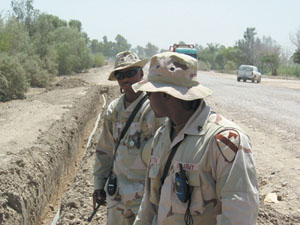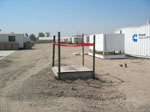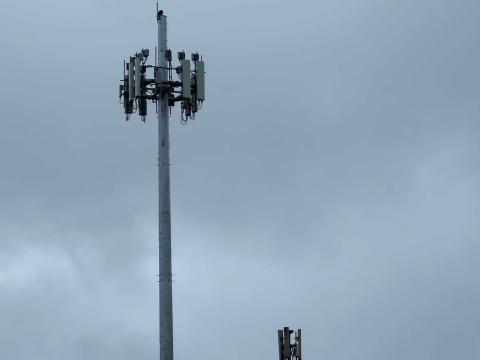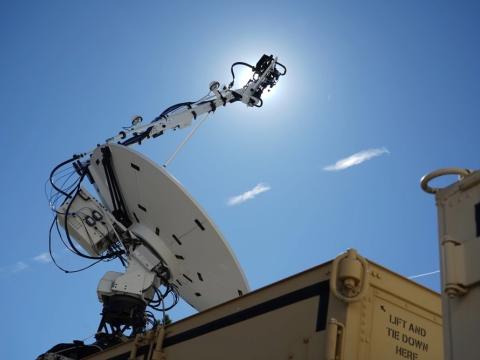Upgrades Enhance Operational Communications
 |
| Staff Sgt. Terrance Toppin, USA (l), cable section supervisor, and Sgt. 1st Class Demetrial Houston, USA, cable platoon sergeant, both with the 13th Signal Battalion, 1st Cavalry Division, check the conduit system near Camp Liberty before engineers backfill the trenches. |
The installation of a fiber optic network has vastly improved communications capabilities for troops fighting in Iraq. Military expertise, commercial technology, hard work and a bit of creativity have resulted in a reliable infrastructure that warfighters at all levels have come to depend on and expect. And, upgrades at command posts have freed up equipment that can be used at forward operating bases.
The 1st Cavalry Division required an extensive communications network during operation Iraqi Freedom 2 to support the large bandwidth requirements of the U.S. Army Battle Command System and the experimental Command Post of the Future (CPOF). The division deployed with more than 30 battalions and grew to more than 50 battalions, while the 13th Signal Battalion contained only 24 small extension nodes. Unique and creative methods were used to provide communications down to the battalion and company levels.
The division is no longer an organization that solely relies on radio and voice communications, but instead it pushes data to the lowest user to increase information flow and decrease mission-processing time. The 1st Cavalry Division improved its knowledge management processes by providing data communications to each company so that users could access and participate in the division’s local area Web publishing capability, a forum to transfer tactics, techniques and procedures quickly from one sector to another.
The CPOF greatly influenced division command and control methods and mission planning. It is a Windows-based collaborative tool suite that combines a three-dimensional map of an area with a collaborative workspace to allow remote mission planning. The CPOF is packaged with Ventrilo voice over Internet protocol (VoIP) software, a product developed by Flagship Industries Incorporated that allows clear voice communications. It also receives real-time information about friendly forces from Blue Force Tracking, Force XXI Battle Command Brigade and Below and the maneuver tracking system.
Because the system is Windows-based, new operators were adept at utilizing it within an hour. Mission planning improved because brigades in different sectors could coordinate with each other using the collaborative planning software, which was faster and easier than radio or digital nonsecure voice telephone (DNVT). The operation cycle was shortened by relying on VoIP communications rather than on the slower and less reliable frequency modulation. The CPOF also became the planning device of choice throughout the division; the commander conducted all battle updates over the CPOF so he could view what the brigade commander was seeing.
The 13th Signal Battalion entered Baghdad during a unique period of the conflict. Warfighters had transitioned from the blitzkrieg mindset to the counter-insurgency mode and operated from base camps where they expected garrison-level communications. The brigade and battalion commanders also expected to be able to contact their company commanders with a telephone and e-mail—not a radio—and use Microsoft Exchange e-mail just as in a continental United States environment.
A plan was in place to commercialize military installations in Iraq, but after almost two years in Baghdad, the effort had not yet begun at the forward operating bases that the 1st Cavalry Division occupied. The 13th Signal Battalion surveyed the situation and realized it had personnel with the necessary skill sets and could obtain the materials to create the network that the maneuver commanders needed.
First, the 13th Signal Battalion increased the capacity of nine small extension nodes (SENs) to 8-megabyte-per-second links by installing CTM100 fiber modems and fiber cable in place of CX11230 cable. This solution used commercial equipment to expand the asynchronous transfer mode (ATM) network and provide more bandwidth than the 2-megabyte-per-second ATM SENs. These SENs were primarily used at brigade command posts to increase bandwidth. Megabit modems and outdoor category 5 cable were used to link most other battalion and company command posts that were not close enough to SENs to receive data communications. However, with the steadily increasing requirements, including air traffic controllers and a National Guard engineer brigade, the demands were more than the organic signal battalion assemblages could satisfy.
The battalion created a fiber network at Camp Liberty, formally Camp Victory North, to create a garrison-type communications system and to use the tactical assemblages at other locations. It took approximately four months to provide fiber service to every headquarters building at Camp Liberty.
Fiber communications were installed in more than five brigade headquarters and over 20 battalion headquarters. More than 60 company-size elements were placed on fiber. The battalion consolidated the “cable dogs” into a 20-person cable team at Camp Liberty. Six-pair, single-mode fiber optic cable was used for the project, and each fiber cable could support two buildings. Each headquarters building used three fiber pairs: one pair for the secret Internet protocol router network (SIPRNET), one pair for the nonsecure Internet protocol router network (NIPRNET) and one pair as a spare.
The project started in late July 2004 with a fiber connection between the division headquarters and the corps headquarters at Camp South Victory. This was accomplished by using rafts to run the cable in the lakes that separated the North and South Victory camps. The cable team members installed more than 100 manholes and more than 10 kilometers of conduit infrastructure so they could place fiber cable into every headquarters building at Camp Liberty. Although it would have been faster to dig a trench and bury the fiber optic cable in the ground, the battalion decided to spend the time needed to build a conduit infrastructure to provide added protection and to allow for future expandability.
The cable team designed a manhole that was then fabricated by a local company through the contracting office. While a local national-owned cement factory was constructing the manholes, the cable team installed fiber through existing Iraqi infrastructure to the buildings outside of the division headquarters. These first four buildings also were used as a testbed to ensure the systems worked correctly and to refine the process. It took approximately two weeks to connect the buildings to the fiber network.
Installing the fiber at Camp Liberty was a joint effort. The cable team worked closely with the 411th National Guard engineers and the 732nd U.S. Air Force engineers. Depending on the availability of equipment, the engineers provided an excavator, backhoe or small earth excavator. The engineers dug a three-foot deep trench for the conduit, and the cable team installed the plastic conduit. After the conduit was installed between the manholes, which were spaced approximately 100 meters apart, the engineers backfilled the trench.
Each area of the forward operating base was connected via its own area distribution node (ADN). For redundancy, each of the four ADNs was connected to two other nodes. The ADN kits comprise Cisco 4507 routers, patch panels and an uninterruptible power supply. Each tactical operations center kit uses two Cisco 3550 switches: one for the SIPRNET and one for the NIPRNET. Each rack also contains an uninterruptible power supply so the equipment can operate for up to 90 minutes without main power.
The fiber team ran fiber cable to each brigade and battalion headquarters building at Camp Liberty. Once the cable was inside the building, the team terminated the cable using a fusion splicer, and enlisted automation specialists worked with the technicians at the network operations center (NOC) to configure and test the switches. After the equipment was tested, the cable team and specialists reran the category 5 wiring for the building. Category 5 cable was installed from the switches and terminated with C-block outlets throughout the building, and cable connecting the telephones and computers was then connected to the C-blocks. Hardened outdoor category 5 cable was installed to connect company command posts and senior officer living quarters to the switches.
VoIP telephones were used over the fiber lines to replace DNVTs. Each brigade-level headquarters building used a Cisco VG248 analog gateway that provided up to 48 regular plain old telephone system (POTS) telephones to each facility and the surrounding area. Each brigade headquarters received approximately 25 telephones from the signal battalion. The brigade-level buildings also received 10 Cisco 7940 VoIP telephones. Each battalion received 12 Cisco 7940 telephones. POTS telephones also were provided where needed for additional users by using Cisco analog telephone adapter (ATA) 188s, which connect two POTS telephones per ATA. Users could still talk to DNVTs by routing through a mobile subscriber equipment (MSE) gateway device called a vantage switch. Four vantage switches were placed throughout Baghdad.
 |
| More than 100 manholes spaced approximately 100 meters apart provide access to the fiber optic cable at Camp Liberty. |
Extending fiber into a building provided voice and data communication to the users without need of a tactical assemblage. By October 2004, the Camp Liberty fiber project freed up more than 10 SENs and a node center to move to other forward operating bases and to provide service for other users in the 1st Cavalry Division area of operations. It also freed up the tactical assemblages to conduct tactical signal missions throughout the Iraqi theater of operations. The units remaining on the base camp did not lose communications as the signal equipment deployed to support operations in Au Najaf and Fallujah. By the end of the project, more than a company’s worth of signal equipment was available to be used on other forward operating bases and in support of other tactical missions.
Several conclusions can be drawn from the 1st Cavalry Division’s fiber optic project at Camp Liberty. First, there are not enough assets for each battalion-equivalent unit to receive a SEN in a forward operating base environment. Second, the maneuver commander can and should use available knowledge management tools, such as CPOF, unmanned aerial vehicle feed, Microsoft Exchange e-mail and collaborative tools. Third, nontactical equipment such as category 5 cable with megabit modems and a fiber network can be used to establish sufficient service for a unit in a forward operating base environment. Using commercially available equipment, the 13th Signal Battalion connected five brigade-level headquarters, more than 20 battalions and 48 company command posts to fiber within five months to expand communications support and allow a company’s worth of signal equipment to be used elsewhere throughout the area of operations.
The fiber project at Camp Liberty was designed for future expandability. The signal battalion is working with the engineers as new buildings are constructed to ensure a communications pipeline is included in the planning and execution. Future projects at the camp include a new military police station and band practice facility as well as connections to the contractor’s facility and fire stations. A plan was designed for the arrival of the 3rd Infantry Division that included installing fiber to the military intelligence division interrogation facility and U.S. Army Corps of Engineers facilities.
As the 3rd Infantry Division takes over the Baghdad network, this fiber project is helping with the transition and establishment of the division’s joint network node (JNN). The fiber is allowing the 3rd Infantry Division to concentrate its JNN assets on forward operating bases that do not yet have a solid infrastructure. At the end of January, the 1st Cavalry network planners and 3rd Infantry Division network planners determined the best placement of the future communications network. For example, the original plan called for a JNN at the 256th National Guard Brigade headquarters, but because the 256th is already connected to the fiber network, the JNN will be able to be used at another location.
In the near term, the 3rd Infantry Division is taking over the maintenance and continued expansion of the Camp Liberty fiber network. Discussions are occurring with the 54th Signal Battalion to establish the directorate of information management for Camp Liberty. The 3rd Infantry Division will continue the work of expanding the communications to meet the requirements and then will maintain the fiber network. However, because the division does not have a signal battalion, who will be replacing the 1st Cavalry Division in overseeing the fiber network has not been determined.
Capt. John S. Transue, USA, is the commander of the Camp Liberty fiber project and the division signal assets, Headquarters and Headquarters Company, 13th Signal Battalion.
Capt. John S. Transue, USA, is the commander of the Camp Liberty fiber project and the division signal assets, Headquarters and Headquarters Company, 13th Signal Battalion.
Web Resource
13th Signal Battalion: www.gordon.army.mil/ocos/rdiv/ACTVCOMP/13thbn.asp




Comments